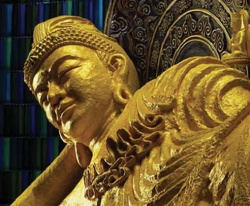Difference between revisions of "The Four Truths"
m (1 revision: Adminos 22 sept 12.43PM) |
|
(No difference)
| |
Latest revision as of 04:45, 22 September 2013
The Four Truths, the first teaching of the Buddha, explains the heart of Buddhist teaching. The recognition of suffering is the first truth because Buddhism is the compassionate view of the world and its spiritual reality. It entails a vision of a better world, and a resolve and plan to do something about it. Buddhism is about the offering of enlightenment to those who are in the darkness of ignorance, true contentment to those who are suffering, and liberation to those who are not free[1]. All of its principles are about this. It is not an intellectual exercise or a philosophical speculation about phenomena. If it is not about bringing comfort, enlightenment and liberation to living beings, it is not Buddhism.
1. The Truth of Suffering (The Disease): All living beings are subject to birth, sickness, old age and death, and wandering through the endless cycles of life & death (samsara) in the mortal existence of the threefold realm. The Great Calm-Observation says: “One’s environment – one’s nation, home, spouse, children, and material wealth - are all completely lost in a single instant. One moment they exist, the next moment they do not. The threefold realm is impermanent and the body is a basket of vipers that can only lead to suffering. The four mountains (of birth, sickness, old age, and death) all close in together and there is nowhere to escape.”
2. The Truth of Its Origination (The Diagnosis): Suffering is caused by ignorant clinging to an impermanent and false self in the threefold realm of mortal existence in Life & Death (Samsara). The Buddha taught that this self-existence causes a never-ending cycle of three inter-penetrating paths that are:
- Destiny-producing deeds (karmas) that produce retributions of suffering
- Retributions of suffering (duhkha) that produce emotional distress
- Emotional distress (klesas) that produces destiny-producing deeds
This was later elaborated into a teaching that is called The Twelve-fold Wheel of Dependence on Origination, which more elaborately explains the never-ending cycle of Life & Death. Origination is the cause and suffering is the effect. Chih-I said: “Origination is based upon the four intoxicating currents of the mind.” These four currents (S. Asravas) are ignorance, sensory desire (for gratification), craving for (self) existence, and attachment to views (opinions).
3. The Truth of Its Extinction (Health): Suffering is extinguished by the extinction of its cause (origination). The extinction of suffering and its origination (the four asravas) is called Nirvana, which literally means 'the blowing out of a candle, or lamp'. Nirvana is defined as the ultimate goal of realization. This goal entails liberation from the false self, its suffering and its wandering in the threefold realm of mortality, the wheel of Life & Death (Samsara). It is not ‘nothingness’ or 'non-existence', but rather a state in which suffering and its origination (cause) are extinguished.
4. The Truth of The Path (The Medicine): The path to this liberation can be summarized as being Morality, Mental Concentration & Spiritual Insight - the threefold spiritual training. Sakyamuni elaborated this into The Noble Eightfold Path and then further elaborated it into The 37 Facets of Spiritual Awakening. The Noble Eightfold Path & the threefold spiritual training:
- Morality (S. Sila) - Proper Conduct, Proper Speech & Proper Livelihood
- Mental Concentration - (S. Samadhi) Proper Diligence, Proper Remembrance & Proper Concentration
- Spiritual Insight (Prajna) - Proper Intent & Proper Views
Footnotes
- ↑ The Threefold Body of Enlightenment:
- A. Enlightenment to those who are in the darkness of ignorance - The Body of Spirituality - Dharmakaya
- B. True contentment to those who are suffering - The Body of Reward - Sambhogahaya
- C. Liberation to those who are not free - The Body of Response - Nirmanakaya
